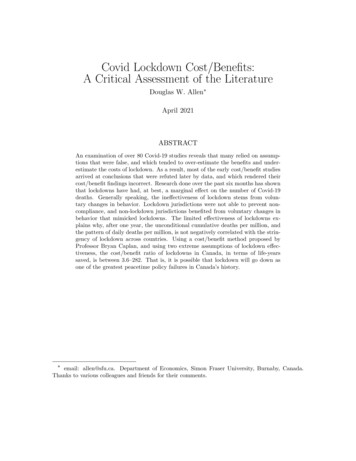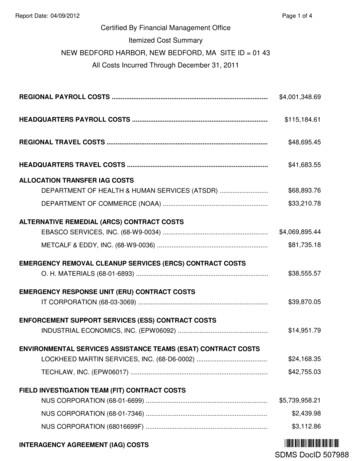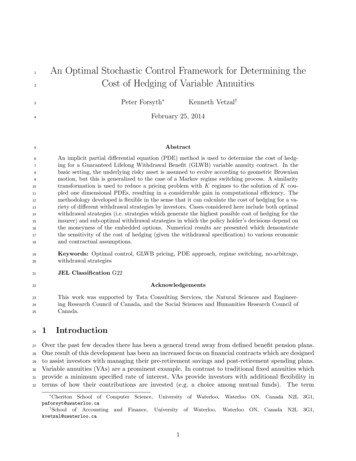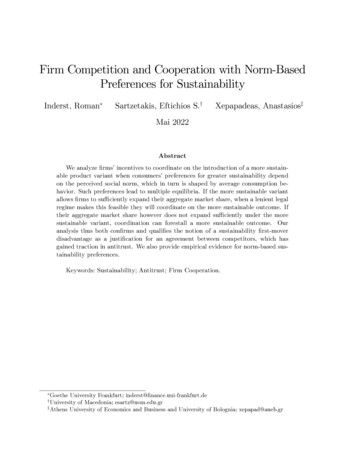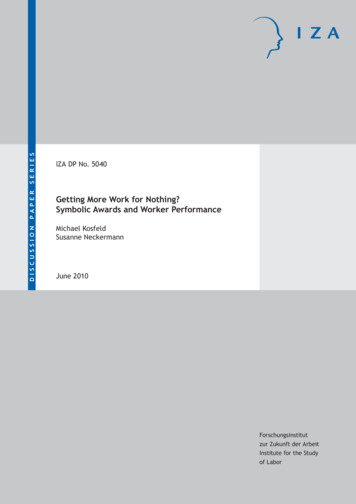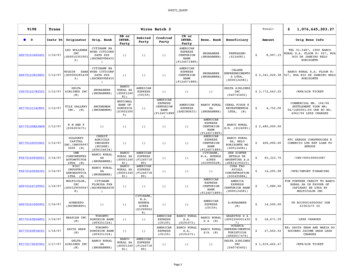
Transcription
The Costs and Benefits of Household Debt Relief*Prepared for the INET Initiative on Private DebtSasha Indarte†WhartonApril 1, 2022AbstractThis paper reviews and extends the literature on the costs and benefits ofhousehold debt relief. Debt relief transfers resources from creditors or taxpayers to debtors. This transfer can increase social welfare when households faceincomplete markets. A lack of insurance against adverse events, such as jobloss and illness, can be offset by the option to reduce debt payments. However,when debt relief imposes larger losses on creditors, possibly through borrowermoral hazard, generous debt relief can reduce the supply of credit. Taxpayerfunded debt relief may also spur creditor moral hazard and inefficiently highlending if creditors do not fully internalize the cost of risky lending. Evidencefor bankruptcy suggests that the insurance benefits outweigh the credit accesscosts. Through data and theory, I highlight parallels across different forms ofdebt relief that may guide future evaluations of optimal debt relief design.* First version: January 4, 2022. This version: April 1, 2022. For helpful comments and suggestions,I thank Paul Mohnen, Natalie Cox, and participants at the 2022 INET Private Debt Initiative. TanviJindal and Jessica Xu provided excellent research assistance.† The Wharton School of the University of Pennsylvania. Email: aindarte@wharton.upenn.edu1
1IntroductionUS policymakers face growing calls for expanded household debt relief. In response to the COVID-19 pandemic, these calls were met in the form of forbearancefor 60 million individuals with loans worth over 2 trillion. As part of this relief,92% of student loans entered COVID-related forbearance plans – fueling a growingdebate over large-scale student debt forgiveness.1 In the backdrop of this debate,Congress has drafted a bill to overhaul to US bankruptcy system. This legislationis motivated by concerns that an earlier reform in 2005 made access to bankruptcyexcessively expensive, time-consuming, and restrictive.2What are the likely costs and benefits of such policy proposals? This paperseeks to shed light on this question by reviewing and extending the literature onthe costs and benefits of household debt relief. Debt relief facilitates a transfer fromcreditors (or taxpayers) to debtors. This transfer is potentially welfare-improvingwhen households lack insurance against costly adverse events such as job loss orillness. By allowing households to reduce debt payments, debt relief can dampenthe impact of these events – providing an implicit form of insurance. On the otherhand, debt relief imposes costs on creditors (in the case of bankruptcy or delinquency) or taxpayers (in the case of government-sponsored debt relief). Whencreditors anticipate larger losses, this incentivizes them to reduce their lending.While default can help defaulters better smooth consumption across different statesof the world, reduced credit access can make it harder for borrowers to smooth consumption over time. The size of the credit supply response depends on the extentto which access to debt relief spurs borrower moral hazard (i.e., increased willing1 These figures refer to debt relief provided under the CARES Act and come from Cherry et al.(2021).2 The proposed bill is the Consumer Bankruptcy Reform Act of 2020. The earlier bill is BankruptcyAbuse Prevention and Consumer Protection Act of 2005.2
ness to default or borrow). Additionally, government-sponsored debt relief has thepotential to create moral hazard on the part of creditors. When creditors do notfully internalize the costs of risky lending, this can lead to inefficiently excessivelending.I first review the major sources of debt relief in the US in Section 2. Householdsreceive debt relief in the form of either defaults or modifications. The key differencebetween these two forms is that modifications entail either cooperation from creditors or are subsidized by the government. The two main types of default households undertake are bankruptcy and delinquency. Nearly one million US households discharge over 100 billion in debt through bankruptcy each year (Indarte,2021). One in ten Americans has filed at some point in their life (Stavins, 2000;Keys, 2018). Nearly 10% of households are delinquent on some debt in a givenmonth, with typical delinquent balances worth over 400 billion in recent years.An additional 1.6 and 10 million consumers received loan modifications throughcredit counseling and debt settlements, respectively (Wilshusen, 2011; Gibbs et al.,2020).3Given the size of these debt relief transfers, there are potentially large costsimposed on the broader economy. I discuss these costs in Section 3. Policies thatincrease the generosity of debt relief at the expense of creditors, such as increasingasset exemptions in bankruptcy or restricting wage garnishment for delinquency,reduce incentives for creditors to lend. The strength of this disincentive dependson several factors. On the creditor side, lending is likely more sensitive to potentiallosses when creditors are in worse financial health. Even with no change in borrower behavior, infra-marginal defaulters receiving more debt relief implies greatercreditor losses. On the borrower side, greater debt relief generosity can trigger3 The10 million settlements include both settlements achieved with a debt settlement companyand those directly negotiated by the consumer.3
moral hazard. Borrowers may be more likely to file (ex post moral hazard) and mayattempt to take on more debt (ex ante moral hazard).Empirical evidence suggests that there are strong creditor responses to debtrelief generosity, but this is despite evidence of limited moral hazard. Gross et al.(2021) estimate that the 2005 bankruptcy reform, which significantly increased barriers to bankruptcy, caused a 70-90 basis point decrease in interest rates on creditcard offers. White (2007) finds that, after the reform, consumers’ revolving creditcard balances rose 5.3%. Regarding moral hazard, Indarte (2021) shows that filing responds weakly to the financial payoff of bankruptcy. A 1,000 increase inthe debt relief offered in bankruptcy leads to a 0.02 percentage point increase inthe likelihood of filing for bankruptcy (a 2.6% relative change). For delinquency,Ganong and Noel (2021) estimate that 70% of mortgage delinquency is due purelyto adverse events rather than a moral hazard response to negative home equity.In this paper, I also take a closer look at bankruptcy and credit usage acrossthe US. I start with the observation that filing rates are lower in states with moregenerous bankruptcy. This is consistent with a strong credit supply response thatlimits access to debt for households more likely to file for bankruptcy, as lowerdebt can offset the incentive to file created by bankruptcy generosity. I show thatbankruptcy generosity predicts much higher mortgage debt and somewhat higherstudent and credit card debt levels. Overall, greater generosity predicts a lowernon-mortgage share of total consumer debt. Mortgage and student debt are generally not discharged in bankruptcy. And bankruptcy can also help households avoidforeclosure and mortgage delinquency by discharging other debts (Mitman, 2016).The higher levels of credit card debt likely reflect a variety of offsetting equilibriumforces. These include increased demand for debt, higher average debt levels due toa lack of filing, and reduced credit supply. Delinquency exhibits little relationship4
with respect to bankruptcy generosity.For government-sponsored modifications, there is also the possibility of creating moral hazard on the part of creditors. When creditors do not fully internalizethe risks of their lending, and instead those risks are borne by taxpayers, creditorscan lend excessively. While this additional credit access may be beneficial to borrowers, on average social welfare can decrease if this distortion to the private costsof lending results in inefficiently high lending and large modification costs.What can justify enduring these costs is the insurance value of debt relief. InSection 4, I present a stylized framework based on Indarte (2021) that characterizesthe consumption-smoothing (i.e., insurance) benefits of debt relief. When households face incomplete markets, adverse events can result in substantial decreases inconsumption and ultimately welfare losses. Debt relief can dampen the impact ofthese events and help prevent an otherwise large decrease in consumption. Indeed,Indarte (2021) estimates for bankruptcy that not filing would cause consumption tobe 29.6-58.4% lower for the marginal bankruptcy filer. When potential debt reliefrecipients’ marginal utility is much higher than that of creditors/taxpayers, transferring resources to these recipients can increase aggregate social welfare. Comparing the insurance benefits against the credit access costs of bankruptcy, Dávila(2020) concludes that increasing the generosity of bankruptcy would improve socialwelfare.Moreover, the insurance provided by bankruptcy is especially valuable in arecession. In this volume, Auclert and Mitman (2022) provides a macroeconomicperspective on the trade-offs of debt relief and finds it can play an important roleas an automatic stabilizer.I conclude with a summary of lessons for debt relief policy and directions forfuture research in Section 5.5
2How do Households Obtain Debt Relief?Households obtain debt relief through two forms: defaults and debt modifications.Both result in a cessation or reduction in payments, and in some cases they mayentail writing down (i.e., erasure) of some or all debt. Defaults are characterized bya lack of consent from or offsetting subsidies to creditors. In contrast, a modification isan agreed-upon or subsidized change in debt contract terms. Next I will describethe primary variants of default and modification available to households, with afocus on the US context.2.1Debt Relief through DefaultThere are two primary forms of household default: bankruptcy and delinquency.Bankruptcy is a de jure form of default that is accessed via a legal process. In contrast, delinquency is a de facto form of default where households choose to stopmaking payments.Bankruptcy. Bankruptcy discharges debt, erasing the legal obligation of the filerto repay creditors. While a discharge compels creditors to cease attempts to collecton debt, it does not erase claims to collateral securing debt, such as a mortgage lien.Because of this, bankruptcy is primarily used to discharge unsecured debt, namelycredit card balances, medical debt, and personal loans.Consumers primarily file under Chapters 7 and 13, with Chapter 7 accountingfor typically 70% of cases.4 Consumers initiate a bankruptcy case by submittinga petition including detailed records on income, debts, and assets. The Chapter7 process generally takes several months and successfully results in a discharge inaround 96% of cases. Chapter 13, on the other hand, requires successful completion4 Rarely, households also file under Chapter 11. However, Chapter 11 accounts for typically lessthan 1% of all non-business bankruptcies (Indarte, 2021).6
of a three to five-year repayment in order to receive a debt discharge. And morethan 50% of Chapter 13 cases are dismissed without a debt discharge (Argyle et al.,2021b).In both Chapters, filers may be compelled to make partial payments to creditors. The size of these payments depend on the filer’s state of residence and assets.State laws specify "exemption limits" on the dollar amount of assets that filers canshelter from creditors in bankruptcy. For example, the homestead exemption capsthe value of home equity that filers can retain in bankruptcy.5 When home equityexceeds the state’s exemption limit, a filer must make payments to creditors equaling the non-exempt portion of home equity.6Bankruptcy is one of the largest sources of household debt relief. On average, 1,681 per US household is discharged annually through bankruptcy.7 In the pasttwo decades, the number of households filing for bankruptcy each year has variedsubstantially but generally averaged close to one million households each year.Figure 1 plots the number of Chapter 7 and 13 cases over time. Filing surged inthe lead up to the implementation of the 2005 Bankruptcy Abuse Prevention andConsumer Protection Act (BAPCPA). The next wave of filings, peaking in 2010,arose during the Great Recession.BAPCPA dramatically increased both the financial and time cost of bankruptcy.This reform raised court fees, substantially increased documentation requirements(which may also increase payments to lawyers), added requirements to take two5 InChapter 7, filers must pay exactly the value of nonexempt assets to receive a discharge. InChapter 13, statute requires that creditors receive at least as much as they would have received inChapter 7. But in principal, Chapter 13 payments can be higher and are set equal to a measuredisposable income (income minus "necessary" expenses).6 Households are not required to sell their home to comply with this requirement. Indeed, onlyaround 1% of home-owning filers with nonexempt equity sell their home in bankruptcy (Indarte,2021).7 Households discharged 2.03 trillion in debt through bankruptcy over 2009-2018 (Courts, 2019).In 2015 there were 120.8 US households.7
Figure 1: Consumer Bankruptcy Filing Over TimeNotes: This figure plots the annual total of Chapter 7 and 13 filings.Source: The American Bankruptcy Institute.financial education courses, and barred households with income above their state’smedian from filing under the weakly cheaper Chapter 7. The average financialcost of filing rose around 500 for both Chapters 7 and 13 to 1,309 and 2,861,respectively (Lupica, 2012). However, the rise in financial costs is likely smallerthan the rise in the total costs (i.e., factoring in the time costs and limitation ofaccess to Chapter 7). Indarte (2021) estimates that a 1,000 increase in the cost offiling reduces annual bankruptcies by 2.63%. A back-of-the-envelope calculation,using the estimate that BAPCPA reduced filings by 492,923 per year (Gross et al.,2021), implies that imposing BAPCPA had the equivalent effect of raising the costof bankruptcy by 11,812.8 This is likely a lower bound as credit access increased8 AppendixTable A5 of Gross et al. (2021) reports an estimated 1,077,689 reduction in filings inthe 114 weeks after BAPCPA (492,923 annually). Relative to the 1,586,683 cases in 2004 prior to thereform, this is approximately a 31% reduction. And 31%/2.63% 11.812.8
after BAPCPA (Gross et al., 2021), which in equilibrium could have an offsettingeffect as a higher debt burden strengthens the incentive to file.Delinquency. Delinquency occurs when a consumer makes zero or less than theminimum stipulated payment on a loan. Pausing payments can bring temporaryrelief from debt. But the accumulation of interest can cause unpaid balances tocompound over time, increasing the borrower’s debt burden.In terms of forgone payments, delinquency regular provides US households asubstantial amount of debt relief. Figure 2 plots the time series of aggregate delinquent balances that are 90 or more days past due. Since 2015, households have hadaround 400 billion in unpaid mortgage and consumer debt (90 or more days pastdue) in a typical month.Figure 2: Aggregate Delinquent Debt BalancesNotes: This figure plots aggregate debt balances that are 90 or more days past due. The underlyingdata comes from a monthly snapshot of delinquent balances.Source: Federal Reserve Bank of New York Consumer Credit Panel.9
If delinquent debt continues to go unpaid, creditors may opt to sell the debt tocollections agencies. On average, 13% of US consumers had a debt in collectionsin a given month. Since 2015 this has begun to steady to decrease to around 9% inrecent years. Conditional on having debt in collections, the amount in collectionhas averaged around 1,000.9When attempts to collect fail, creditors and debtcollectors may eventually seek a court judgment against the debtor. The judgmentmay then allow wage garnishment, where the debtor’s employer is compelled towithhold a portion of their paycheck and send it directly to the creditor/debt collector.2.2Debt Relief through ModificationAn alternative to default-based debt relief is modification. The key difference isthat modification requires the cooperation of creditors, sometimes with offsettingsubsidies. Below, I describe the main sources of modifications available to UShouseholds.Credit Counseling. Credit counseling is a service primarily provided by nonprofits (Gibbs et al., 2020). Credit counseling entails a simultaneous, multilateralnegotiation with the borrower’s creditors to propose a modified sequence of payments (a "debt management plan" or "DMP"). Often this involves a reduction inminimum payments and may entail a decrease in balances, with the goal of increasing the feasibility of repaying the debt. Creditors have an incentive to agreeto the DMP when a borrower would have otherwise repaid less.The number of people using credit counseling has been similar over time tothe number filing for bankruptcy. 1.6 million US consumers participated in a DMParranged through credit counseling in 2011 (Wilshusen, 2011). In 2019, this figure9 These collections figures come from the November 2021 Quarterly Report on Household Debt andCredit produced by the Federal Reserve Bank of New York.10
was closer to half a million consumers (Gibbs et al., 2020).10 In 2011, participantsrepaid between 1.5-2.5 billion credit card debt through a DMP (Wilshusen, 2011).Debt Settlement Companies. When households are unable to successfully complete a DMP, they may instead turn to a debt settlement company (DSC). DSCs aretypically for-profit firms that bilaterally and sequentially negotiate with creditorsfor a reduction in total balances (Gibbs et al., 2020). A drawback to this bilateralappraoch is that it may give rise to a hold-up problem. Some creditors can demand(or pursue through garnishment) levels of repayment that limit the set of viableworkouts with other creditors. DSCs successfully achieve a settlement 60% of thetime (Briesch, 2009). Consumers settled 2 million credit accounts in 2019, with presettlement balances totaling 6 billion (Gibbs et al., 2020).DSCs have been the subject of many complaints of deceptive practices andregulatory enforcement actions (Gibbs et al., 2020). The fees associated with usingDSCs are also high, averaging around 15-30% of the debt retied (Wilshusen, 2011).The financial burden of these fee payments likely contributes to the high rate ofdelinquency among DSC participants (Wilshusen, 2011). Participants may thenface the usual consequences of delinquency such as repossession, debt enteringcollections, and wage garnishment.Non-Intermediated Settlements. Consumers may also negotiate directly withlenders. Typically this happens after debt collectors or creditors initiate legal proceedings to begin garnishment. During this process, the debtor may opt to settleout of court with the collector or creditor. Wilshusen (2011) reports 10 million consumers had settled an account either through a DSC or through their own negotia10 Note: BAPCPA introduced a credit counseling requirement prior to filing for bankruptcy. Butthis relationship is not mechanical as the would-be filers can only proceed to bankruptcy if theycannot instead arrange a feasible debt management plan.11
tion with a debt collector or creditor as of 2011, suggesting an upper bound on howcommon this form of debt relief is.Using quasi-experimental variation in the occurrence of out-of-court settlements, Cheng et al. (2021) finds such settlements increase financial distress. Notably,rates of delinquency, bankruptcy, and foreclosure increase by 20%, 160%, and 130%(respectively). These worse outcomes may arise because settlements typically entail larger upfront payments. Within the first year a of an out-of-court settlement,consumers typically pay nearly four times as much as they would under garnishment (Cheng et al., 2021).Government Sponsored Debt Relief. Notable examples of large-scale government debt relief include the Home Affordable Modification Program (HAMP) during the Great Recession and the Coronavirus Aid, Relief, and Economic Security(CARES) Act. HAMP subsidized mortgage modifications for 1.8 million households experiencing financial hardship. The modifications extended maturities toreduce payments and, for some applicants, provided 67,000 in principal forgiveness (Ganong and Noel, 2020).In contrast, the CARES Act offered debt relief to a broader set of loans, including mortgages for investor-owned properties and student loans.11 Between Marchand October of 2020, 60 million individuals saw 1.1 trillion and 580 billion inmortgage and student loans (respectively) enter forbearance. Over this time period, these households saved 43 billion in debt payments (Cherry et al., 2021).3What are the Costs of Household Debt Relief?We now turn to the costs and benefits of debt relief, starting with the costs. Thereare direct costs of accessing debt relief borne by the recipient. But indirect costs can11 Government-owned loans were eligible.This includes GSE-eligible loans and the bulk of studentloans.12
also arise. Creditor anticipation of greater losses can make them reluctant to lend.Additionally, government-sponsored debt relief can spur moral hazard, diminishing creditor incentives to screen risky borrowers.3.1Whats are the Direct Costs of Household Debt Relief?Credit Access. Most forms of debt relief result in a derogatory flag on the consumer’s credit report. These flags can significantly lower credit scores, which playa central role in creditors’ screening of borrowers and can therefore limit creditaccess. Bankruptcy triggers a flag that remains on credit reports for seven to tenyears. Removal of bankruptcy flags significantly increases credit access (Musto,2004). Recent estimates find on average that credit card limits rise by 778 and balances increase by 290 in the first year after removal (Gross et al., 2020). Both delinquency and settlements (through either a DSC or out-of-court settlement) lead toderogatory flags that can remain for seven years. A DMP initially creates a derogatory flag in the consumer’s credit report, but this flag is removed upon successfulcompletion of the plan, which last no more than five years (Wilshusen, 2011).Government-sponsored debt relief can also impact credit scores. HAMP initially resulted in a derogatory flag (the same one that a borrower receives from aconsumer-negotiated modification), that could remain for up to seven years.12 Incontrast, the CARES Act took greater lengths to limit the credit score impact ofparticipation. The CARES Act amended the Fair Credit Reporting Act to requirereporting borrowers in COVID-19-related forbearance plans as current so long asthey were current prior to participating in a modification.The ultimate credit score and access impacts can also differ among the formsof debt relief due to their impact on debt levels. Bankruptcy reduces debt levels,12 A distinct flag was later introduced, but this could have a similar negative impact on creditaccess.13
which also negatively impact credit scores. And if the filer avoids delinquencyafter filing, this can speed up the recovery of credit scores. On the other hand, protracted delinquency can further lower credit scores when indebtedness grows dueto compounding interest. Indeed, Albanesi and Nosal (2020) finds that borrowerswho are initially similar on observable characteristics tend to fair better in terms ofboth credit scores and access if they file for bankruptcy rather than remain delinquent. A DMP can also improve credit scores by gradually reducing debt balancesover time. In contrast, the debt reduction benefits of credit counseling and debtsettlements are not realized until the new payments are completed.Employment Costs. Derogatory flags may also negatively impact labor marketoutcomes. Credit reports are a widely-used tool to screen potential hires (Corbaeand Glover, 2020). If delinquency is predictive of worse job performance, employers have an incentive to avoid hiring these workers or offer a lower wage.13 Inthe context of Sweden, Bos et al. (2018) finds positive effects of bankruptcy flagremovals on both employment rates and earnings. However, in the US context,Dobbie et al. (2019) estimates a precise null effect of flag removal on labor marketoutcomes. In fact, Dobbie and Song (2015) estimates a positive effect of receivinga Chapter 13 discharge on employment. Filers experience on average a 5,562 increase in annual income (a 25.1% increase) and the probability of being employedrises 6.8 percentage points (an 8.3% increase).Part of the labor market benefits of bankruptcy may stem from its triggering ofan automatic stay, which prohibits continued collection efforts, including garnishment. Garnishment reduces take-home pay, which in turn diminishes incentivesto remain employed. And to reduce contact with debt collectors, borrowers may13 Corbae and Glover (2020) and Chatterjee et al. (2020) study such models where greater delinquency results from impatience, which is correlated with an individual’s labor productivity.14
changes addresses, but relocating may also make it harder to maintain employment. Empirically, Dobbie and Song (2015) finds that the labor market benefits ofChapter 13 are largest among filers in states with higher rates of wage garnishment.Stigma. Debt relief recipients may also experience non-pecuniary "stigma" costs.Quantifying such costs is challenging, but body of research suggests that stigmais an important determinant of the default decision. Violating a perceived "moralobligation" to repay debt can entail a non-pecuniary cost. Indeed, a large surveyfound 82% of people agree with the statement that "it is morally wrong to walkaway from a house when one can afford to pay the monthly mortgage" (Guiso etal., 2013).In practice, consumer behavior aligns with these self-reports of a perceivedstigma. Text notifications with moralizing language reduced the frequency of creditcard delinquency 4.4 percentage points (a 6.7% reduction) in a field experiment inIndonesia (Bursztyn et al., 2019). Moreover, even if households do not directly experience disutility from defaulting, social stigma may also impose a non-pecuniarycost from default. Diep-Nguyen and Dang (2019) find in experiment studying borrowers in Vietnam find that anticipated disclosure of non-payment to friends, family, or coworkers serving as a "reference" deters default. In the context of debtsettlements, Cheng et al. (2021) finds in a survey that 17% of respondents wouldagree to an out-of-court settlement even it required them to pay more than theywould had they instead lost in court. The top-cited reason behind this motivationwas "perceived employment and social stigma as well as bad feelings from losingin court."Evidence from bankruptcy suggests that the sum total of direct credit access,employment, and non-pecuniary costs are large. Indarte (2021) estimates that thesecosts are equivalent to a 41.6% decrease in annual consumption for the marginal15
bankruptcy filer. Taking stock of the research on bankruptcy discussed above,which suggests a limited role for credit access and employment costs, stigma costsare likely a major source of these substantial costs estimated in Indarte (2021).3.2Whats are the Indirect Costs of Household Debt Relief?Debt relief entails a transfer from creditors (or taxpayers) to debtors. This transfercan increase social welfare when debtors have a higher marginal utility of consumption. But in equilibrium, creditors may adapt their behavior in ways thatcreate additional indirect costs, offsetting the welfare gains from this transfer.Default and Credit Access. When a larger fraction of debt is unpaid or more borrowers default, this imposes larger losses on creditors. The expectation of higherlosses due to default incentivizes lenders to reduce the supply of credit. In turn,this lowers equilibrium lending and raises the cost of credit.The size of the credit supply response depends on several factors. On the creditor side, the response is stronger when lending is more sensitive to expected losses.This could arise, for example, when creditors are in worse financial health. Onthe borrower side, greater moral hazard leads to more losses. Policies that increasethe generosity of debt relief (for example, increasing the homestead exemption forbankruptcy filers) can increase creditor losses in three ways. First, infra-marginalfilers now receive more debt relief – the transfer from creditors to these debtorsis larger. Second, more generous debt relief may prompt more debtors to file forbankruptcy. Third, if filing becomes more likely, borrowers may be more willing totake on debt. The first is a mechanical effect, the second and third effects are formsex post and ex ante moral hazard (respectively).While there is some debate, research on default generally finds a small role forof moral hazard. Indarte (2021) estimates small ex post moral hazard for consumer16
bankruptcy: a 1,000 increase the generosity of debt relief provided in bankruptcyleads to a 0.02 percentage point increase in the filing rate among homeowners(a 2.6% relative change). In contrast, a 1,000 change in cash-on-hand reducesthe probability of filing by 0.09 percentage points (12.6% relative change). Thestronger filing response to cash-on-hand that is available whether or not the borrower files for bankruptcy indicates that a lack of liquidity is a more powerfuldriver of bankruptcy than a moral hazard response to its financial payoff. Moreover, if the change in the filing rate is smaller, th
to which access to debt relief spurs borrower moral hazard (i.e., increased willing-1These figures refer to debt relief provided under the CARES Act and come fromCherry et al. (2021). 2The proposed bill is the Consumer Bankruptcy Reform Act of 2020. The earlier bill is Bankruptcy Abuse Prevention and Consumer Protection Act of 2005. 2


